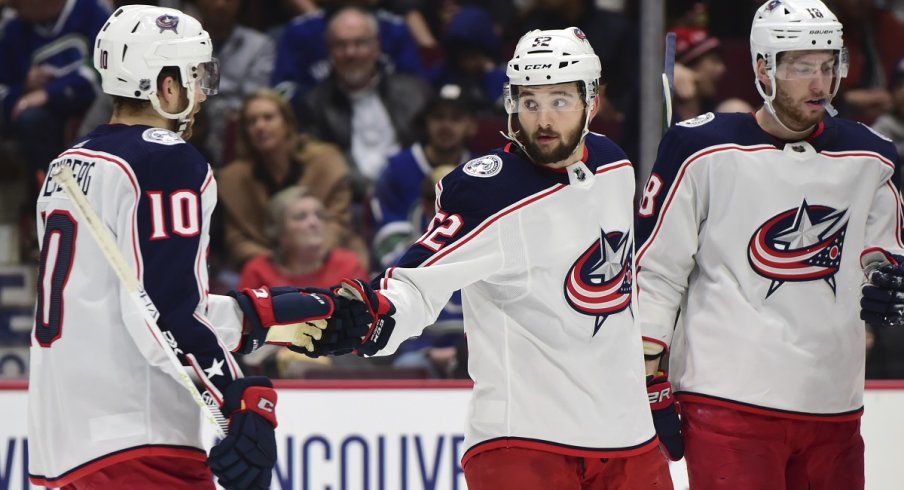It's not a secret that the Columbus Blue Jackets have struggled to score as the playoff race intensifies.
In the team's 2-1 win over the Vancouver Canucks, the Blue Jackets found success utilizing what coaches term 'low-to-high' plays.
Both their first and second goals were score in a similar fashion, with a Blue Jackets' player winning a puck battle behind the net, swinging around the net and forcing the Canucks' defenders to turn their heads away from the dangerous areas in front of the net, before finding the eventual goal-scorer with a pass into the slot.
Here's how they happened:
A beautiful feed from PLD, and Bemstrom makes no mistake. #CBJ pic.twitter.com/EQLzXl3HGR
— 1st Ohio Battery (@1stOhioBattery) March 9, 2020
On the first goal, Alexander Wennberg started the cycle, and Pierre-Luc Dubois masterfully shielded the puck from Alex Edler (#23/VAN). If you freeze the video at 0:10, you'll see that Vancouver has four players with eyes on Dubois' stick (plus the goaltender). At 0:11, Dubois makes a sublime pass to find Emil Bemstrom in a high-danger scoring area, and he utilizes his lethal one-timer to score his 10th goal of the season.
Full marks to Dubois for doing the dirty work on this goal, but I'd be remiss to not mention more about Bemstrom. A common refrain in hockey is that good goal scorers "get lost" in coverage. It truly is an art, and it's why players who don't have cannons for shots (re: Cam Atkinson) still manage to score at a high clip in the NHL. In hockey parlance, Bemstrom found "soft ice", ice in a dangerous area that's not being actively covered. Think of it like a wide receiver finding a dead spot in zone coverage.
Re-watch the above video but isolate Bemstrom. At 0:10, he's not remotely open for a pass. But Dubois and the Swede have developed chemistry, and Dubois knew that if he stalled long enough, he would draw enough attention to give Bemstrom time to find that soft ice. At 0:11, he gives himself one last push into the middle of the ice, and Dubois finds him. The rest is elementary for a player with a shot like Bemstrom's.
Savard puts it on a tee, and Robinson hammers home an absolute rocket. #CBJ pic.twitter.com/1affT2WCvg
— 1st Ohio Battery (@1stOhioBattery) March 9, 2020
On the second goal, it's a similar refrain. Just like the first goal, the Blue Jackets are relentless in their forecheck and establish zone time and control of the puck behind the net. After a Vladislav Gavrikov shot misses the net (best seen on the replay at 0:33), David Savard pinches down and his momentum carries him behind the net. Savard emulates Dubois perfectly and finds Eric Robinson in soft ice. Robinson, who looked more like Bemstrom than a power forward, unleashed a wicked one-timer to score his seventh goal of the season.
Again, Savard makes a great pass, but watch it again and pay special attention to Robinson, who does an excellent job making himself available as a support option.
As you've probably realized by now, the low to high play puts a great deal of strain on the defensive team, who are often caught over-pursuing the puck carrier to the detriment of the team, and the goaltender, who must track a puck from behind the net to a dangerous area, locate the pass, locate the player, and locate the shot. That's a big ask, and it's why Columbus found success.
Last thing I'll mention: This low-to-high type of play is something that all hockey teams work on, but I couldn't help but wonder if the Blue Jackets' coaching staff/advance scout identified a weakness in the Canucks' defensive zone structure, or if the Blue Jackets really just found seemingly random success with the same dangerous play twice in the same period.
Whatever it is, look for them to continue to look for this type of play as they try to hunt down a playoff berth for the fourth consecutive year.
